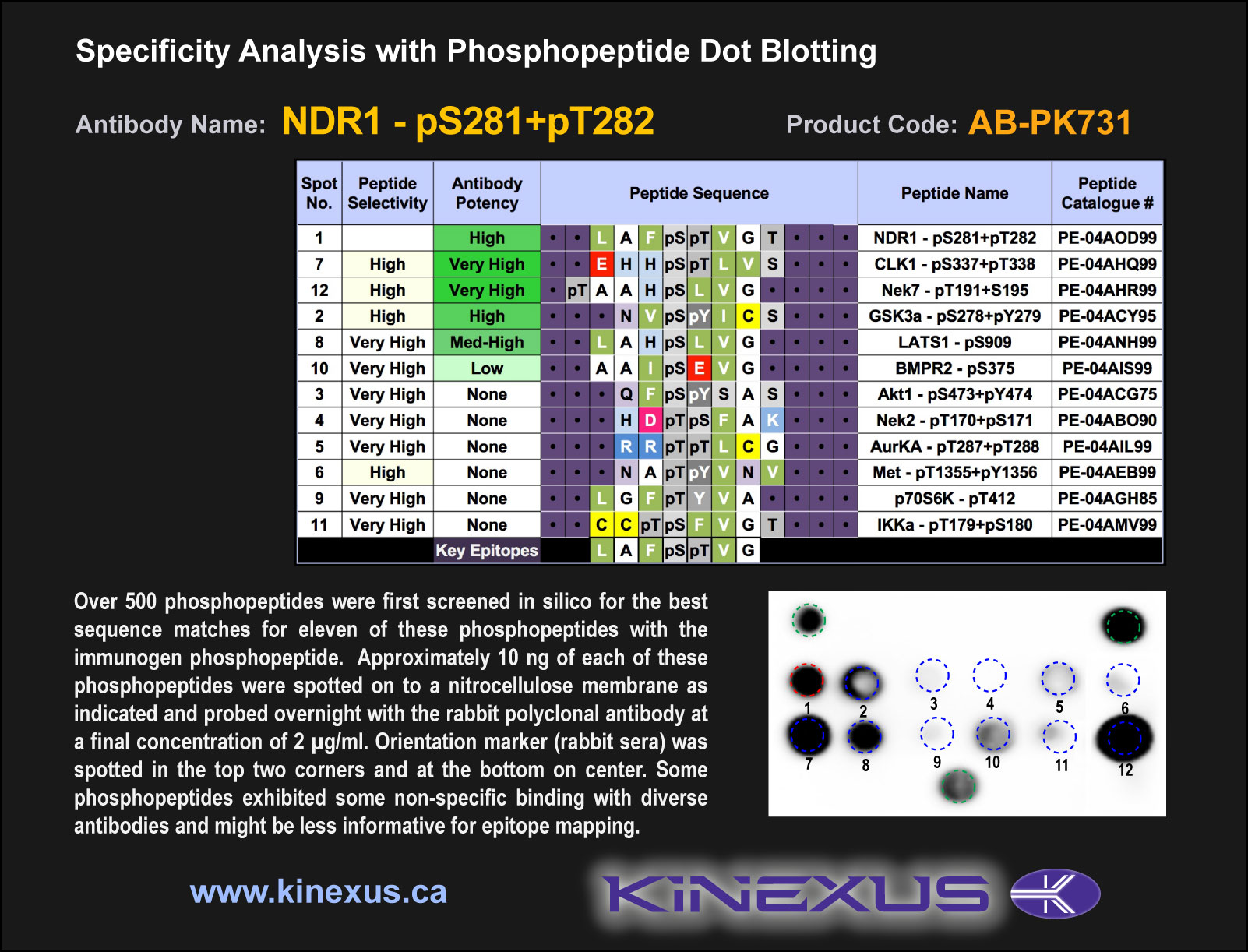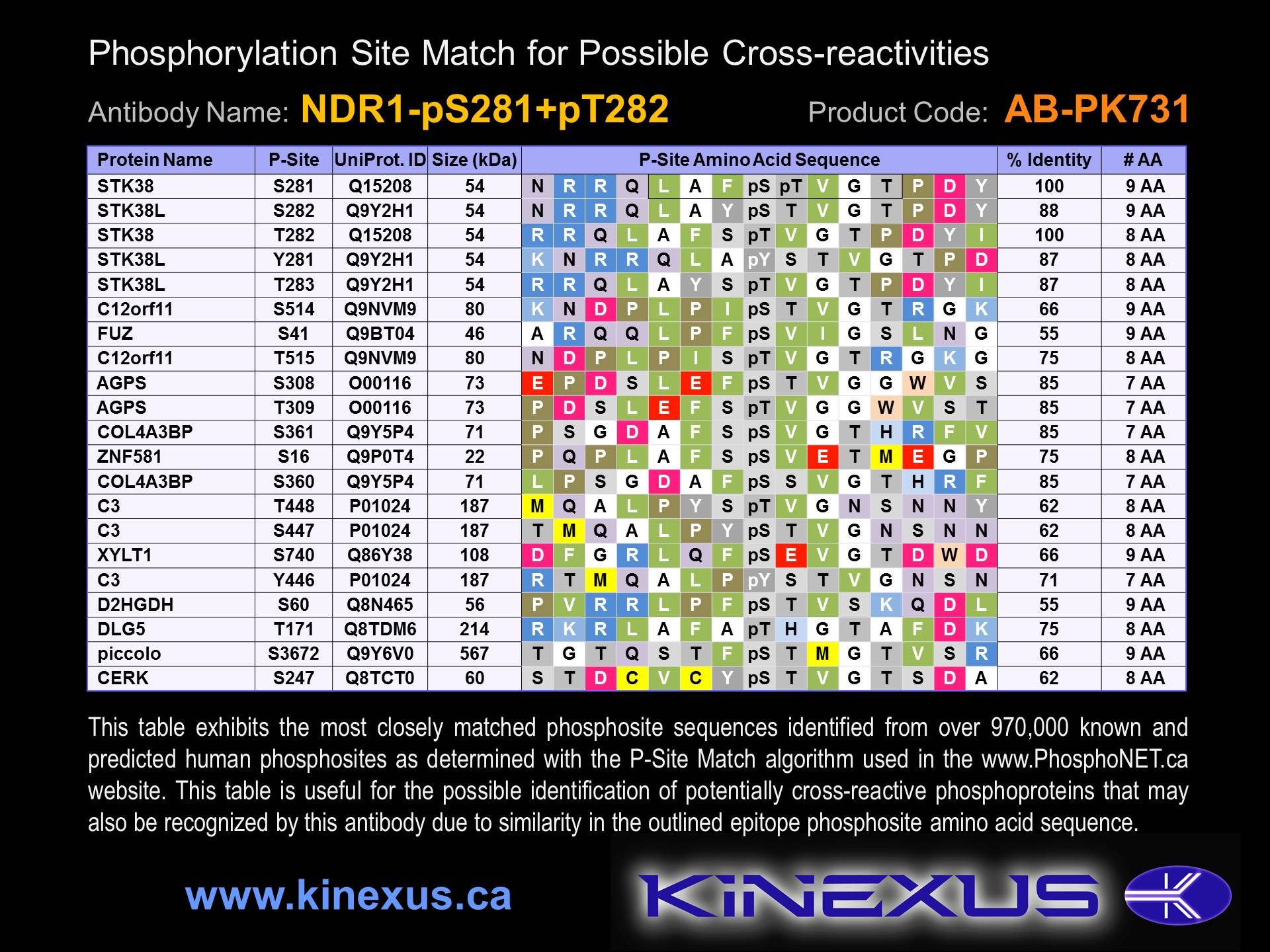Product Name: NDR1-pS281+pT282
Product Number: AB-PK731
| Size: | 25 µg | Price: | 89.00 | |
| $US |
Target Full Name: Serine/threonine-protein kinase 38
Target Alias: AA617404; DJ108K11.2; NDR1 protein kinase; NDR; STK38; CCDS4822.1; ENSG00000112079
Product Type Specific: Protein kinase phosphosite-specific antibody
Antibody Code: PK731
Antibody Target Type: Phosphosite-specific
Antibody Phosphosite: S281+T282
Protein UniProt: Q15208
Protein SigNET: Q15208
Antibody Type: Polyclonal
Antibody Host Species: Rabbit
Target Alias: AA617404; DJ108K11.2; NDR1 protein kinase; NDR; STK38; CCDS4822.1; ENSG00000112079
Product Type Specific: Protein kinase phosphosite-specific antibody
Antibody Code: PK731
Antibody Target Type: Phosphosite-specific
Antibody Phosphosite: S281+T282
Protein UniProt: Q15208
Protein SigNET: Q15208
Antibody Type: Polyclonal
Antibody Host Species: Rabbit
Antibody Immunogen Source: Human NDR1 (NDR, STK38) sequence peptide Cat. No.: PE-04AOD99
Antibody Immunogen Sequence: LAF(pS)(pT)VGT(bA)C
Antibody Immunogen Description: Corresponds to amino acid residues L278 to T285; In the protein kinase catalytic domain activation T loop region between subdomains VII and VIII.
Antibody Immunogen Sequence: LAF(pS)(pT)VGT(bA)C
Antibody Immunogen Description: Corresponds to amino acid residues L278 to T285; In the protein kinase catalytic domain activation T loop region between subdomains VII and VIII.
Production Method: The immunizing peptide was produced by solid phase synthesis on a multipep peptide synthesizer and purified by reverse-phase hplc chromatography. Purity was assessed by analytical hplc and the amino acid sequence confirmed by mass spectrometry analysis. This peptide was coupled to KLH prior to immunization into rabbits. New Zealand White rabbits were subcutaneously injected with KLH-coupled immunizing peptide every 4 weeks for 4 months. The sera from these animals was applied onto an agarose column to which the immunogen peptide was thio-linked. Antibody was eluted from the column with 0.1 M glycine, pH 2.5. Subsequently, the antibody solution was neutralized to pH 7.0 with saturated Tris.This antibody was also subject to negative purification over phosphotyrosine-agarose.
Antibody Modification: Unconjugated. Contact KInexus if you are interest in having the antibody biotinylated or coupled with fluorescent dyes.
Antibody Modification: Unconjugated. Contact KInexus if you are interest in having the antibody biotinylated or coupled with fluorescent dyes.
Antibody Concentration: 1 mg/ml
Storage Buffer: Phosphate buffered saline pH 7.4, 0.05% Thimerasol
Storage Conditions: For long term storage, keep frozen at -40°C or lower. Stock solution can be kept at +4°C for more than 3 months. Avoid repeated freeze-thaw cycles.
Product Use: Western blotting | Antibody microarray
Antibody Dilution Recommended: 2 µg/ml for immunoblotting
Antibody Potency: Medium immunoreactivity with immunogen peptide on dot blots.
Antibody Species Reactivity: Human
Antibody Positive Control: The observed molecular mass of the processed target protein on SDS-PAGE gels is reported to be around 52-57 kDa.
Storage Buffer: Phosphate buffered saline pH 7.4, 0.05% Thimerasol
Storage Conditions: For long term storage, keep frozen at -40°C or lower. Stock solution can be kept at +4°C for more than 3 months. Avoid repeated freeze-thaw cycles.
Product Use: Western blotting | Antibody microarray
Antibody Dilution Recommended: 2 µg/ml for immunoblotting
Antibody Potency: Medium immunoreactivity with immunogen peptide on dot blots.
Antibody Species Reactivity: Human
Antibody Positive Control: The observed molecular mass of the processed target protein on SDS-PAGE gels is reported to be around 52-57 kDa.
Scientific Background: NDR1 (STK38) is a protein-serine/threonine kinase of the AGC group and NDR family. It is activated by binding of S100B, which releases autoinhibitory N-lobe interactions, enabling ATP to bind and the autophosphorylation of S281. Phosphorylation at S281 increases phosphotransferase activity and interaction with MOBP. T444 then undergoes calcium-dependent phosphorylation by an upstream kinase. Interactions between phosphorylated T444 and the N-lobe promote additional structural changes that complete the activation of the kinase. Phosphorylation at T74 induces interaction with S100B. T444 then undergoes calcium-dependent phosphorylation by an upstream kinase. T74A, K118A, S281A, and T444A mutations are involved in decreased or loss of autophosphorylation and kinase activity. NDR1 is a negative regulator of MAP3K1/2 signalling. It converts MAP3K2 from its phosphorylated form to its nonphosphorylated form and inhibits autophosphorylation of MAP3K2. NDR1 is an important regulator of Myc's oncogenic activity in human B-cell lymphomas. It also regulates G/S cell cycle transition. The MAPK/ERK pathway has been implicated in oncogenesis as either a promoter or inhibitor depending on the cancer system.
Figure 1. Epitope mapping of NDR1-pS281+pT282 antibody with similar phosphopeptides on dot blots.
Figure 2. Identification of phosphosites related to NDR1-pS281+pT282.
© Kinexus Bioinformatics Corporation 2017



